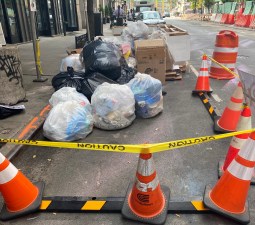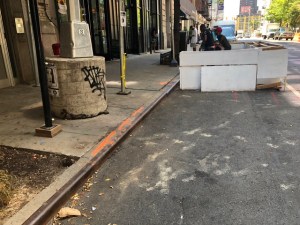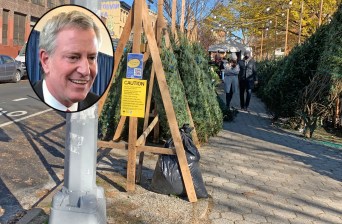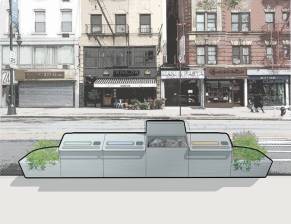TRASH TALK! Mayor Wants To Think About Getting Filthy, Rodent-Infested Garbage Bags out of Pedestrians’ Way
You're welcome, New York.
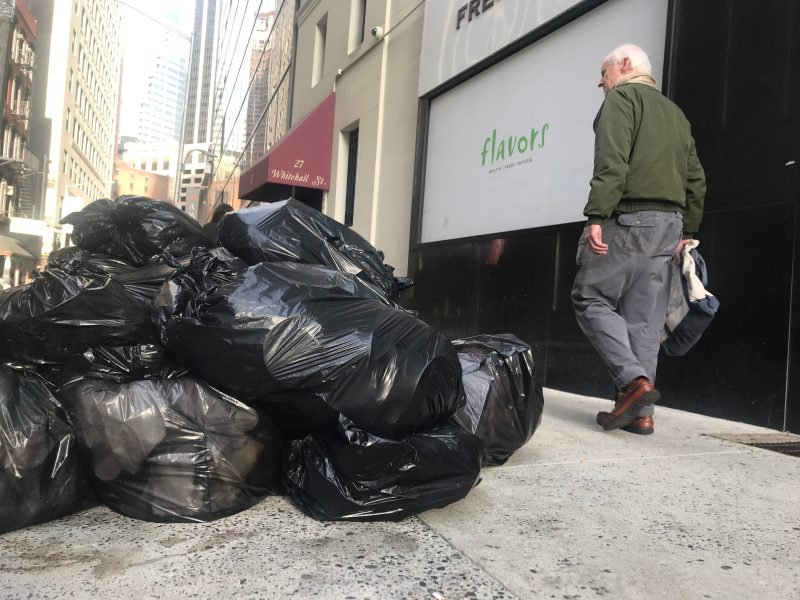
Mayor de Blasio said on Tuesday that he would “be happy” to consider ways to get piles of garbage out of the way of the city’s long-suffering, rat-harassed pedestrians, who must tip-toe through sluices of dripping refuse every afternoon when the sidewalks become de facto trash heaps even though plenty of curbside space is available.
Under questioning from Streetsblog at Hizzoner’s morning press conference, de Blasio admitted that he considered curbside trash corrals “an interesting idea” — and one that he certainly did not dismiss out of hand.
“It sure is an interesting idea. It’s something I’m happy to look at,” he said, emphasizing that “I hear you loud and clear” that New York’s pedestrians need to have the space they need to keep New York “one of the great walking cities of the world.”

“We have to protect that,” he added. “We know open streets and open restaurants are part of our future. They’ve been a huge success. And that will take up some of the curbside areas. [Trash corrals are] obviously a much bigger idea. Look, we have to look at a host of things going forward. … Open streets and open restaurants have been a revelation and certainly points in the direction of being even more creative going forward.”
If, indeed, the mayor is open to the idea of letting residential building owners put their garbage in the street rather than in huge mounds on already-cramped sidewalks, it represents a quick evolution from earlier this summer, when the Department of Transportation ordered the removal of a pilot trash corral created by CHEKPEDS, the Hells Kitchen pedestrian advocacy group.
But weeks after that removal, the DOT has apparently warmed to the CHEKPEDS idea and has asked the group to find five locations around the city where the idea can be tested. CHEKPEDS has been sending out surveys to building management companies in hopes of finding a partner.
“Are bags of trash on the sidewalk a problem in your area?” the come-on from CHEKPEDS begins.”CHEKPEDS has heard of problems such as not enough space for pedestrians to walk, rodent infestations, not enough space to store bags in between collections, and leakage from bags onto the sidewalk. [We] are working with the city to convey these needs and develop a potential solution.”
The group hopes to find a building in each borough. [Interested buildings or management companies can fill out the group’s survey in English or Spanish.]
More and more organizations and advocacy groups — and, even the New York Times — are starting to see the illogic of trash-covered sidewalks, or, as Streetopia UWS observed this week, trash-filled tree pits, when there is so much roadside space just off the sidewalk along the curb.
This isn’t what we mean by a trash corral. Free parking on both sides of the street, but we choose to endanger a tree instead of using the curb. ?@NYC_DOT? ?@NYCSanitation? ?@Chekpeds? ?@StreetsblogNYC? pic.twitter.com/5FJAyrkJAr
— Streetopia Upper West Side (@StreetopiaUWS) November 3, 2020
Just as the coronavirus pandemic hit New York hard, the Department of Sanitation had initiated a pilot program to get trash off the sidewalks. But that program has been stalled.
The car-owning minority of the city will no doubt push back on any repurposing of public space that would benefit the pedestrian majority. In the last few weeks, community boards in Astoria, Jackson Heights and Lower Manhattan have shown increasing hostility to any attempt to use what drivers consider their parking in favor of other uses.
But in the same press conference, the mayor reiterated that he is willing to take on car owners over their claim to a parking entitlement in favor of the larger public.
“We have gone down this road before: as we were adding bike lanes, Select Bus Service, and other changes, we’ve often had opposition from community boards,” the mayor said. “I don’t want to stereotype community boards [but] they have opposed some of the progress we needed and I said consistently, ‘We’ll listen, but we believe in Vision Zero. We will keep making Vision Zero changes. We believe in open streets and bike lanes.’ And community boards are there to advise and sometimes they point out a way to make it better. But we have set our direction — and that’s what we are going to keep doing.”

